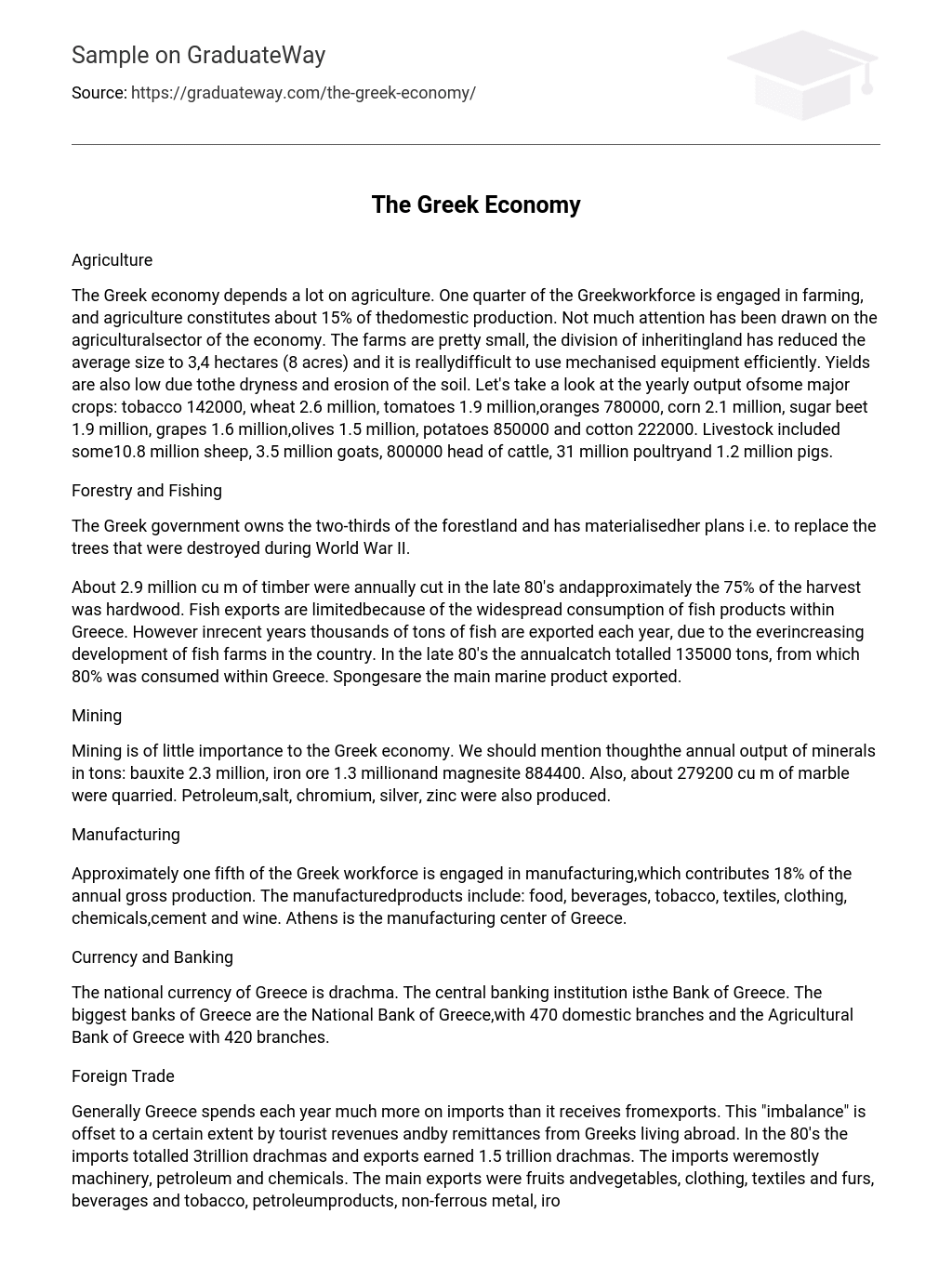Agriculture
The Greek economy depends a lot on agriculture. One quarter of the Greekworkforce is engaged in farming, and agriculture constitutes about 15% of thedomestic production. Not much attention has been drawn on the agriculturalsector of the economy. The farms are pretty small, the division of inheritingland has reduced the average size to 3,4 hectares (8 acres) and it is reallydifficult to use mechanised equipment efficiently. Yields are also low due tothe dryness and erosion of the soil. Let’s take a look at the yearly output ofsome major crops: tobacco 142000, wheat 2.6 million, tomatoes 1.9 million,oranges 780000, corn 2.1 million, sugar beet 1.9 million, grapes 1.6 million,olives 1.5 million, potatoes 850000 and cotton 222000. Livestock included some10.8 million sheep, 3.5 million goats, 800000 head of cattle, 31 million poultryand 1.2 million pigs.
Forestry and Fishing
The Greek government owns the two-thirds of the forestland and has materialisedher plans i.e. to replace the trees that were destroyed during World War II.
About 2.9 million cu m of timber were annually cut in the late 80’s andapproximately the 75% of the harvest was hardwood. Fish exports are limitedbecause of the widespread consumption of fish products within Greece. However inrecent years thousands of tons of fish are exported each year, due to the everincreasing development of fish farms in the country. In the late 80’s the annualcatch totalled 135000 tons, from which 80% was consumed within Greece. Spongesare the main marine product exported.
Mining
Mining is of little importance to the Greek economy. We should mention thoughthe annual output of minerals in tons: bauxite 2.3 million, iron ore 1.3 millionand magnesite 884400. Also, about 279200 cu m of marble were quarried. Petroleum,salt, chromium, silver, zinc were also produced.
Manufacturing
Approximately one fifth of the Greek workforce is engaged in manufacturing,which contributes 18% of the annual gross production. The manufacturedproducts include: food, beverages, tobacco, textiles, clothing, chemicals,cement and wine. Athens is the manufacturing center of Greece.
Currency and Banking
The national currency of Greece is drachma. The central banking institution isthe Bank of Greece. The biggest banks of Greece are the National Bank of Greece,with 470 domestic branches and the Agricultural Bank of Greece with 420 branches.
Foreign Trade
Generally Greece spends each year much more on imports than it receives fromexports. This “imbalance” is offset to a certain extent by tourist revenues andby remittances from Greeks living abroad. In the 80’s the imports totalled 3trillion drachmas and exports earned 1.5 trillion drachmas. The imports weremostly machinery, petroleum and chemicals. The main exports were fruits andvegetables, clothing, textiles and furs, beverages and tobacco, petroleumproducts, non-ferrous metal, iron and steel. The principal trade patterns were:Germany, Italy, Great Britain, France, the Netherlands, the United States andJapan. The countries of the European Union account for more that 60% of Greece’syearly total trade.
Tourism
Greek economy depends a lot on tourism. Due to the many archaeological placesand buildings, the sun, the blue sky, the sea and the Mediterranean climate,many people visit each year Greece. In the late 80’s 8.1 million touristsvisited Greece. The receipts from tourism were totalled 300 billion drachmas.
Bibliography
- “Encarta” Encyclopaedia, Greece’, Microsoft, 1996 Category: Business





